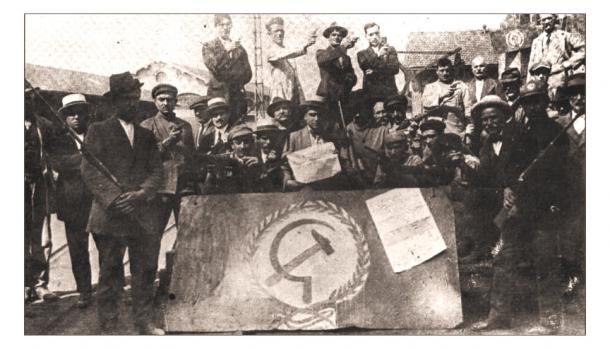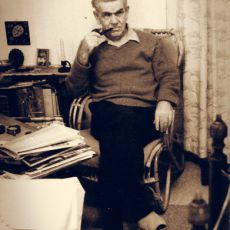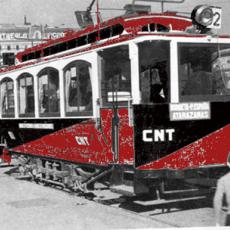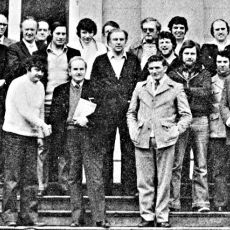Proletarian Power: The Turin Factory Councils 1919-1920
The Bienno Rosso, the two red years which threatened to overthrow Italian capitalism, represents one of the high points of working class struggle in the history of the world labor movement.
The Turin Factory Council movement which emerged at the height of the Bienno Rosso, the two red years which threatened to overthrow Italian capitalism, represents one of the high points of working class struggle in the history of the world labor movement. The events played a formative role in the thought of Antonio Gramsci and the political practice of what was to become the Communist Party of Italy. The occupation and its aftermath also drew out the contradictions of the Italian Socialist Party which, despite formal adherence to the line of the Comintern, remained a bastion of mostly verbal radicalism and practical reformism and which, at the crucial moments of the post-war radicalization, stood back and retreated from any serious confrontation with the state or capital. The far reaching radicalism and immense revolutionary potential of the movement succeeded in striking fear into the hears of the ruling class, yet the failure of the PSI to provide effective revolutionary leadership and carry the movement to a revolutionary climax on a national scale led to a radical shift in the balance of class forces to the side of now terrified ruling elites which saw its salvation in fascism.
The Italy which emerged out of World War 1 was one where a strengthened and aggressive industrial capitalist class faced a worker’s movement which had grown significantly in numbers and social power. This growth in industrial capital was concentrated in Milan, Genoa, and above all in Turin, and is captured well by statistics showing that “The Fiat company’s capital leapt from 17 million lire in 1914 to 200 million lire in 1919, that of steel and engineering concern Ansaldo from 30 to 500 million, and engineering firm Ilva from 30 million in 1916 to 300 million two years later.”1
The corresponding growth in the proletariat was also immense, “the workforce of Milan increased fivefold between 1915 and the end of 1916; Fiat’s workforce grew from 4,300 in 1914 to over 40,000 in 1918. There were over 900,000 workers in war industries by the end of the war .”2 Production was so vital to the Italian war effort that many workers were excused from military service, a fact which was also skillfully deployed by the ruling elites to pit peasants against the ‘privileged’ ‘shirkers’ in the city.Yet despite wages which stood at nominally high levels and exemption from military service, the conditions of most industrial workers remained wretched. As Gwyn Williams describes, “One estimate records a rise in the cost-of-living index from 132.7 in 1915 to 409.1 in 1918, while the index for daily earnings rose from 3.54 lire to 6.04 lire in the same period.”3 At the same time profit rates soared for the industrial bourgeoisie, with an average rate of profit around 16% and with rates as high as 20% and even 40% being common.4
This drastic inequality made the transformation of the seething class antagonism and hatred into open conflict and insurrection inevitable despite the militarization of labor, a conflict which finally came to the front in Turin in August of 1917. This conflict, both in the deeply radical actions of the workers and in the spontaneous, vacillating character of the socialist leadership, was in many ways a dress rehearsal for the far broader and more important conflict which would erupt during the Bienno Rossa. News of the revolution in Russia was the spark for a new wave of radicalization, and a tour of Russian Mensheviks and Social Revolutionaries found itself to its own dismay greeted everywhere by thronging masses who shouted “Viva Lenin!”5
Shortly after the delegations visit to Turin, the city exploded in a spontaneous burst of working class radicalism. Sparked by a breakdown in bread supplies on August 21st the factories burst into anti-war demonstrations. Clashes began with police and soldiers and “The working-class quarters were barricaded, barracks attacked for arms, two churches sacked.”6 However while the socialists rallied to the cause and praised the workers’ courage seeing it as a revolutionary breakthrough worth being associated with, they said to give up any further violence and to return to their jobs.
In addition to a lack of any national co-ordination of similar actions, the action was crushed above all by military force, against which despite fraternization and appeals the necessary breakdown in military discipline among the peasant soldiers proved difficult. “It proved easy to whip up their hatred against exempted industrial workers. Sardinian peasants in uniform had no hesitation in shooting down Turin workers in August 1917”7 The uprising ended in defeat, and although a radical wing of the socialists around Bordiga and Gramsci (Who was in the aftermath promoted to the leadership of the Turin section) began to further coalesce, much of the party tailed behind defense of the country in the aftermath of the defeat at Caporetto and failed to build a revolutionary base.
The movement that had been suppressed in August 1917 was to flare up again as the most radical and advanced part of the Bienno Rossa as Italy began the process of demobilization and demilitarization in 1919. The international political context, with the victorious Bolshevik revolution desperately holding on to power in Russia, with revolution in Hungary, with Germany having undergone its own democratic revolution and where a growing Communist Party threatened to make a socialist revolution, ensured that even in a good economic climate the coming years would be stormy.
The radicalizing potential of the war was there, “Italy mobilized 5.25 million men. At least 615,000 were killed, half a million disabled and a million wounded. Workers, peasants and soldiers greeted the end of the war with hope for the future and a sense that their sacrifices would be rewarded… the government promised soldiers land after the war, and restitution to workers for the sacrifices made during the conflict.”8 These hopes and expectations were to be shattered and were to contribute to the deep post-war radicalization of the Italian proletariat and peasantry.
The economic crisis brought about by demobilization was also of tremendous significance. “Exports had collapsed, imports had swollen, emigration had ceased, the transportation system was run down. There had been a serious fall in food production… The coal shortage was no less desperate…Masses of capital were locked up in installations now unprofitable and reconversion to peacetime rhythms proved very difficult.”9 Food riots and protests exploded in June and July, with ‘soviets’ formed in some areas and widespread rebellion. Had a serious Leninist party existed, the seizure of power may even have been on the agenda. However the PSI was not this party, and the movements remained to disparate and unconnected to prove a coordinated threat to the bourgeois order.10 The context of the two red years was however potentially revolutionary, and this potentially revolutionary environment must be kept in mind in examining the development and potential of the Turin Factory Councils.
It was in this context of radical working class struggle, that on May 1st 1919 the first issue of Ordine Nuovo appears, which however would not become the worker’s political organ it developed into until June 21st when it took up the question of internal factory commissions, which were to lay at the heart of the Turin movement.11 These internal factory commissions first emerged when in 1906 FIOM won a contract recognizing the 10 hour day and establishing an elected internal factory commission to handle greivances and discipline similar to shop stewards in Britain and Germany.12 They then became more predominant as elected regulating bodies during the war which helped regulate production with management and resolve industrial disputes from the side of the workers.13
Their significance as organs increased in 1918 when they began to emerge as a focal point for organizing both within and against the Union, which attempted to take over and render them subsidiary in the summer of 1918. Demands for the recognition of the commissions began to figure prominently right beside wage demands and were a focal point for working class militants who saw the union as collaborationist.14 In organizing and promoting these alternative organs of ‘dual power’ within the factory, the Turin far left “unleashed and rode a mighty surge of working-class revolt and aspiration which drew in anarchists, syndicalists, libertarians and the hitherto apathetic… it was L’Ordine Nuovo and Antonio Gramsci in particular who gave it form and public style.”15
This process began to take shape with an article by Andrea Viglongo, a strong supporter of Gramsci, who wrote an article in L’Ordine Nuovo criticizing Fiat-Centro workers who “turned the new internal commission into a strengthened base for FIOM”16 whereas the right to elect the factory commissioners should be universal for workers. Although this would produce contradictions, it was necessary if factory commissions were to evolve as organs of the proletariat. In his view “The answer was for the councils to develop in complete autonomy from the unions and to assume a position vis-a-vis unions parallel to that of soviets and unions in Russia. Unions, thus in practice diminished to subsidiary agents, should be integrated into the general movement led by the councils.”17
On August 31, 1919, the Brevetti-Fiat plant sets up a system whereby elected workshop commissars are voted for on the basis of every worker having the vote with only union members able to be elected, a compromise which puts the council first as an organ of struggle and which is hailed by L’Ordine Nuovo. At Brevetti-Fiat, “Elections for commissars were held in every work-unit; the elections took a week and out of 2,000 workers, only three or four abstained. And from this point on, the council movement began to burn through the industrial complex of Turin lke a fire-storm.”18 The power of the factory commissions to act as organs representing and mobilizing the whole working class of the factories as opposed to the smaller, less representative trade union, made the possibility of working class control over production, and ultimately a mobilization of the working class to seize power, a real possibility.
In the aftermath of the Brevetti-Fiat factory election the system pioneered by the workers there in which union members would be elected to the commissions by all the workers set off a rapid growth in the system, promoted by socialist activists around L’Ordino Nuovo and by many of the workers themselves, expanding from Fiat into the Chemical, Shoe-making and timber industries and even provoking significant debate at the national congress of the Milan chemical and rubber workers.19 This explosion of factory commissions culminated in a ‘quasi-general assembly’ of workshop commissars on October 31st, a day before the Turin section of the FIOM union was to meet.20 The Turin assembly of workshop commissars succeeded in taking over the local union, this was followed by the winning of the Turin section of the PSI, and then the winning of the local chamber of labor which in theory spoke for the whole regions working class and which called for the formation of factory committees and workers councils.21
However the movement failed to really reach outside of Turin, in Milan for example the major trade union, the CGL (General Conferderation of Labor), “backed by the PSI, held the line against the Turin infection. It was prepared to countenance, indeed create ‘commissars’; even, in the last resort, to tolerate some extension to non-union men, but union control had to be firmly maintained.”22 The factory council movement, in other words, faced the same challenge that all revolutionaries faced in the Italian socialist movement, the threat of practical reformism and vacillation concealed under superficial, verbal adherence to radical, communist politics. Gramsci and the Turin movement found itself opposed not only by the right wing of the PSI, but also by the extreme left led by Bordiga who maintained an extremely sectarian, purist vision of a tightly disciplined truly communist party which would seize power. In these circumstances attempts to win or renew the party failed, and neither through the party or through wider council organization was the Turin model spread to the rest of Italy, leaving it isolated and potentially vulnerable against a gathering industrialist led counter-revolution.
The first decisive conflict came in April, before the factory council movement could succeed in spreading nationally. “The industrialists had carefully prepared for the conflict. They seized an opportunity presented to them by clumsy and ill-considered action by some workers. They struck while Turin was still isolated.”23 The dispute emerged not over economic demands but over the question of power, of whether workers or the owners held sway within the factory. The immediate dispute was over a change to ‘Summer-Time’, a change which reminded workers of war-time forced labor. Workers responded at one Fiat plant by setting back the hands of the clock themselves and faced dismissal by the owners. The situation escalated until a general assembly of commissars called for sit-in strikes throughout the whole metal industry in response.
The industrialists hit back with everything, backed up by tens of thousands of troops who had been moved into Turin. The industrialists proclaimed a lockout and factories were occupied by soldiers, ringed with barbed wire and machine guns. In negotiations, “the employers presented a series of demands which amounted to a castration of the commissar system”24 and on the 13th of April, a general strike was called in Turin in defense of the factory council system, it spread to the whole provinces of Turin, Novara, Alessandria and Pavia. It brought out half a million workers and involved 4 million people. Yet at the critical moment, when it was necessary that the strike either expand to all of Italy or collapse in negotiations, the national council of the PSI rejected the call for a General strike and the Turin section was left hanging by itself. Though the strike mobilized unprecedented numbers of workers, it ended in defeat with a re-imposition of factory director and union control to the detriment of the new council system on April 24th.25This defeat however was only to set the stage for the far deeper and more significant crisis which was to emerge in September.
A mutiny of troops at Ancona who were being ordered to Albania, and a widespread campaign against arms production given the apparent danger of a declaration of war against the Soviet Union and the use of produced weapons against that revolution, set the stage for the unfolding of a widespread crisis which would draw in most of the Italian labor movement. Sparked by a dispute in Milan which escalated to a factory occupation after an employer lockout, the stage was set for a decisive conflict.
“As in April, the initiative lay with the employers. Strongly organized in Confindustria [A coalition of industrialists] and regional consortia… alarmed by the anti-plutocratic tone of the Giolitti government and its tentative gestures towards the socialist, the industrialists struck, struck hard and fought with grim tenacity. The massive working-class action was essentially a response.”26
The movement, in the aftermath of the defeat of the earlier Turin action and the subsequent discrediting of Gramsci’s wing within the party, was primarily led or pushed forward by syndicalists in the USI (Unione Sindacale Italiana) who had been growing rapidly.27 After a back and forth dispute with industrialist attempts to dismiss workers and union responses through go slow and work-to-rule strikes, “It was clear that the industrialists were determined to stage a lock-out. USI called for a preventative occupation…On 30 August… the Romeo management locked out its 2,000 workers.
The response of the Milan section of FIOM was automatic. Workers moved in to occupy over 300 factories in the Milan area.”28 The union section in Turin actually attempted to hold back the expansion of the occupations, but a general employer lockout forced their hand and brought half a million workers across Italy into a general factory occupation movement. “Between 1 and 4 September, the occupations rolled forward through Italy, not only in the industrial heartland around Milan, Turin and Genoa, but in Rome, Florence, Naples, Palermo, in a forest of red and black flags and a fanfare of workers’ bands.”29 The factory occupations not only put a halt to production at the behest of the industrialists but actually began to use the factories to produce themselves under their own economic order. Technical and engineering personal sometimes joined the movement, however as the days passed and the revolutionary implications became clearer more and more withdrew, with one of the exceptions being Turin with its past experience of factories under ‘communist order’. On September 6th it became clear that the movement reached beyond the factories, as peasants near Potenza marched on and seized nearby estates.30 It was without question the most widespread working class movement in Italian history, and one of the most significant in the history of the world working class, yet this tremendous movement would find itself without any leadership, any organized body capable of directing it towards a conquest of power beyond the factory walls.
Although the movement lasted for weeks, it’s fate was sealed with the PSI’s complete failure to take stock of and advance the revolutionary situation which they found themselves in. On the 10thof September the PSI leaders and CGL union leaders met and in a dramatic confrontation the CGL forsook takeing power and offered it to the PSI “You assume responsibility. We who do not feel able to shoulder this responsibility… we say we will withdraw. We submit our resignation…You take the leadership of the movement.”31 Yet the party which was offered leadership, offered power, was incapable of assuming any sort of leadership. A letter written by Lenin, Zinoviev and Bukharin accurately described the situation which the party was in.
“In Italy there are at hand all the most important conditions for a genuinely popular, great proletarian revolution… Every day brings news of disturbances. All eyewitnesses – including the Italian delegates – assert and reiterate that the situation in Italy is profoundly revolutionary. Nevertheless, in many cases, the party stands aside, without attempting to generalize the movement, to give it slogans… to turn it into a decisive offensive against the bourgeois state.”32
The Party executive chose to stand aside at the critical moment, out of fear being rendered incapable of accepting responsibility for directing the movement towards any revolutionary conquest of power. The Party executive chose as it always had to tail the masses; it stepped back, and the question of communist revolution was essentially put to a vote by the Milan branch of the CGL union, with one resolution calling in effect for Communist revolution and other for reformist economic negotiations. The convention “liquidated the political solution with the complicity of the party leadership itself, which wanted to lose”33 The results of the vote, with delegates representing about half a million for reform and 400,000 for the dictatorship of the proletariat did underscore a divide between the militant industrial working class and the broader labor movement, however this was a divide that was the product of the failure of the PSI to do anything to attempt to unite and seriously direct the immense spontaneous and organized bursts of working class and peasant resistance over the last two years.
The reformist ‘victory’, with pay to workers for production that happened under workers control and vague promises of an increase in workers control within the factories was illusory. A renewed economic crisis which drove up unemployment set the stage for violent counter-revolution. Industrialists who no longer saw the parliamentary government as capable of defending their interests poured money into the burgeoning fascist movement as the political force which would represent them. What was left of the Turin factory councils was destroyed by employer, state and fascist action in April 1921, only a few months after the supposed victory of the September occupations.34
In the first half 1921, “fascist squads, climbing through the year towards the 300,000 mark, mobile and well-equipped, destroyed 59 case del popolo, 119 camere, 107 co-operatives, 83 peasant leagues, 141 socialist centres; they killed over a hundred, wounded thousands and terrorized whole communities…Frequently, police and army followed up.”35 The violent revolution which so terrified and was forsaken by the official leaders of Italian Socialism came in the form of the brutal fascist counter-revolution. All the gradual gains and reforms came to nothing against the rifle butt of the state and the brutal regime of fascism. Although the history of the Turin factory councils was heroic and their potential was immense, the hostility to their revolutionary program of workers’ power by the official unions against which they were constructed and above all by the hostility of the vacillating PSI doomed them and the Italian working class to defeat. The movement succeeded in scaring the bourgeoisie sufficiently to chase them into the arms of fascism, without going far enough to take power for the new proletarian order being built out of the factories. The movement’s limits were described well by a letter from the Comintern’s executive,
“You cannot win by the seizure of factories and workshops alone…the scope of this movement must be extended, generalized, the question raised to a general political level, in other words the movement broadened into a general uprising with the object of overthrowing the bourgeoisie by the seizure of power by the working class… This is the only way to salvation; otherwise the disintegration and collapse of the mighty and magnificent movement that has begun is inevitable.”36
Yet there existed no political organ capable of extending and generalizing the Turin movement, into directing the massive discontent of the two red years into a serious revolutionary organization capable of contesting state power. The price which the left would pay for its failure to do this, to follow up revolutionary rhetoric with revolutionary action, was over 20 years of Fascist rule which would obliterate the left until World War 2 opened up a new epoch of revolutionary struggle.





Comments
Post new comment